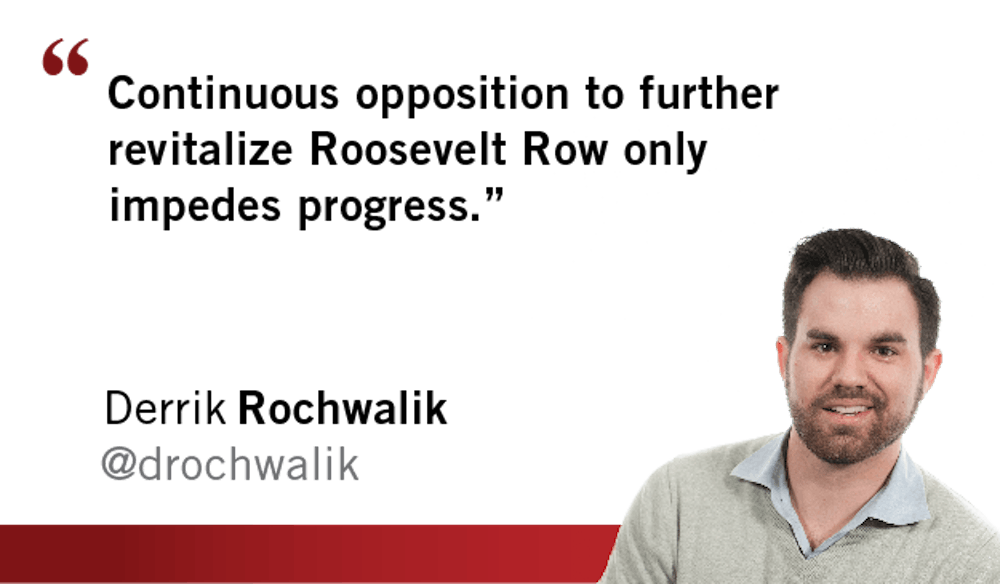Fans of First Friday are familiar with the walks held in downtown Phoenix. Even dorm halls and communities organize a monthly trip on the light rail to visit the eclectic group of artists and their works intrinsically belonging to the arts district known as Roosevelt Row.
Artists first moved to Roosevelt Row after the land where their last district, located on the outskirts of downtown, was sold to make way for Bank One Ballpark — now known as Chase Fields. The old neighborhood of condemned buildings, decrepit communes and drug dens was an inexpensive place for artists to rent live-in studios and for small business pop-up shops to take roots and begin to grow. Slowly, the community began to become revitalized and nationally known as an area for the arts.

Soon, this attention caught the eyes of developers looking to move in and build housing communities to further revitalize the creative part of downtown. However due to the inherent mistrust — some with good reason — these urbanite artists have toward anything big business, a fight began to ensue in order to save Roosevelt Row.
Roosevelt Row is in danger! At least, that’s what many artists and art enthusiasts of the downtown area are crying. In fact, Roosevelt Row has never been in a better position to grow and continue to be the tourist attraction the city of Phoenix advertises it as. With many land developers interested, Roosevelt Row is presented with a unique opportunity to continue to grow but keep its vibe and feel.
The community feels under attack as most recently, three well-known properties within the Roosevelt Row district were sold privately and purchased by private developers. One such location, GreenHAUS, located on 222 E. Roosevelt, is scheduled for demolition within the first quarter of this year. Although the last tenants have since moved their business to Portland, the community feels the urge to want to save the vacant building. But why?
The building houses three wall murals, two of which were painted by the late artist Ted DeGrazia. According to locals, the two wall murals are not just works of art, but part of the community. One can be easily removed from the wall and transferred. However, the larger of the two can’t be so easily moved — if at all. Painted on dry wall directly plastered to brick, the wall mural depicting the early stages of the process to make grain alcohol will likely have to be moved with the entirety of the wall.
This presents an expensive problem to the developers. However, Baron Properties, the developer, has offered numerous times to allow an organization or individuals to come in, with their own money, and relocate the artwork. At first, this seemed like an agreement the community and the DeGrazia Foundation, located in Tucson, could get behind. However, due to the dragging of feet on the part of the community to rally behind the preservation of the artwork, Baron Properties has since recanted its proposal.
In place of GreenHAUS, a four-story, 111-unit complex is to move in with a 145-spot underground parking garage. Many artists and community organizers see this as a step toward gentrification, an attempt to move the artists out of the arts district. However, Baron Properties has never been more concerned for the arts. Offering a large section of the ground floor to be set aside for an art gallery where local artists can go and display their work, Baron is trying to work with the surrounding community to find something which works. After all, this is what originally attracted Baron Properties to the area.
The concern to potential developers is the opposition the community has toward new housing developments they feel gentrify the area. However, one ironic piece to this puzzle is the city-owned land a developer was supposed to break ground on at the tail end of last year. The housing development going in was supposed to be 80 percent affordable housing for people 55 years or older. The “anti-gentrification” community rallied and effectively scared off the affordable housing developer, returning the land back to the city.
How can a group and a community cry gentrification to the developers coming in, when some of them are looking to provide affordable housing to an area already plagued with low income? The artists and community fear a 1990s repeat, where they’re uprooted and told to find someplace else. This just isn’t the case. The developers moving in were attracted by the arts district; they only hope to help it grow. Continuous opposition to these plans to further revitalize only impedes progress. Should Baron Properties just build around the wall mural and include it in their already planned gallery? Yes. Do they have to? No. In the end, it’s all private property, and the owner of the land has the right to do with it as they please.
Reach the columnist at Derrik.Rochwalik@asu.edu or follow @drochwalik on Twitter
Like The State Press on Facebook and follow @statepress on Twitter
Editor’s note: The opinions presented in this column are the author’s and do not imply any endorsement from The State Press or its editors.
Want to join the conversation? Send an email to opiniondesk.statepress@gmail.com. Keep letters under 300 words and be sure to include your university affiliation. Anonymity will not be granted.




